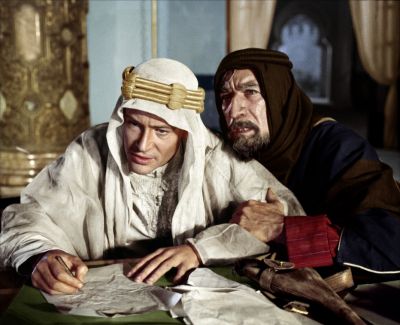
LAWRENCE OF ARABIA
(Lawrence d'Arabia, Gb/1962) R.: David Lean. D.: 222'. V. inglese
Digitale. Restaurato da Sony Pictures Entertainment
Introduce Grover Crisp (Sony Pictures Entertainment)
Serata promossa da Mare Termale Bolognese
La versione restaurata di Lawrence of Arabia, presentata al Festival di Cannes nella sezione Cannes Classics, si basa sul Director's Cut uscito nel 1989, che comprende 21 minuti di materiale inedito, portando la durata complessiva del film a 3 ore e 42 minuti. Nel corso degli anni il film era stato pesantemente rimaneggiato, ma nel 1988 è stata intrapresa la sua ricostruzione, prodotta da Robert A. Harris e Jim Painten. David Lean e Anne V. Coates, montatrice dell'edizione originale, hanno poi lavorato sul film per realizzare la versione Director's Cut. Sarà un film enormemente lungo, malgrado copra un periodo di soli due anni. Durerà almeno tre ore, forse persino quattro. Abbiamo dovuto trattare la storia con estrema economia drammatica. Per questo siamo stati costretti a condensare alcuni fatti e a riunire sei personaggi in uno. Nella storia di Lawrence erano coinvolti molti militari. Sarebbe stato impossibile inserirli tutti nella sceneggiatura, così ne abbiamo uno solo (interpretato da Anthony Quayle) che li rappresenta come 'militare inglese' ed è complementare al personaggio del generale Allenby interpretato da Jack Hawkins. Credo che questa sia la migliore interpretazione di Hawkins. [...] Nel nostro ritratto di Lawrence non abbiamo potuto né voluto evitare gli aspetti controversi della sua vita privata. Per esempio mostriamo il suo lato masochista. Non abbiamo insinuato che Lawrence fosse omosessuale, ma tutto dipende dalla definizione che viene data di omosessuale. [...] Non abbiamo omesso il clima politico dell'epoca, le relazioni tra arabi e britannici; ma il contesto politico non era il nostro principale interesse. Spero soprattutto di aver creato un eroe davvero singolare. Non vedo l'ora di conoscere la reazione degli spettatori. Non so come prenderanno il Lawrence che abbiamo deciso di mostrare, perché per certi versi è una figura eroica affatto tradizionale e alcuni suoi gesti sono eroici, ma fa anche cose che possono scandalizzare gli spettatori. Penso che il pubblico non sia abituato a questo genere di shock. [...] Il film è stato girato in 65mm con processo Panavision. Abbiamo potuto vedere tutto il materiale girato in Giordania solo una volta tornati in Gran Bretagna. [...] Supervisiono io stesso il montaggio, soprattutto le scene d'azione più complesse. Dato che sono stato montatore, per me è difficile tenere le mani lontane dalla celluloide. In fase di sceneggiatura nessuno può prevedere come verrà montata una scena; ma quando giro cerco di avere già in mente un'idea di montaggio. So già quali scene mi serviranno e tento di ottenerle, spostando qua e là gli attori senza ripetere tutta l'azione con una diversa disposizione. A volte ci si sbaglia e allora mi maledico di non aver girato un campo lungo che in seguito si sarebbe rivelato necessario.
(David Lean, Out of the Wilderness, "Films and Filming", n. 100, gennaio 1963)
The restored version, presented at Cannes Classics, was made from the Director's Cut in 1989, when the film was rereleased in cinemas. It includes 21 minutes Lawrence of Arabia of unreleased footage, bringing the total running time to 3 hours 42 minutes. Over the years the film was heavily cut, but in 1988 a reconstruction of the film was undertaken, produced by Robert A. Harris and Jim Painten. David Lean and original editor Anne V. Coates then worked on the film to create Lean's Director's Cut. In spite of the span of time being only two years we have an enormously long film. It will be at least three hours, perhaps nearer four. We have had to use a lot of a dramatic economy. Consequently we have short-circuited certain incidents, and run six characters into one. There were many military men concerned in the Lawrence story. It would be impossible to include them all in a screenplay so we have one (played by Anthony Quayle) who represents them as 'an English military character', complimentary to the role Jack Hawkins has as General Allenby. It is, I believe, the best performance Hawkins has ever given. [...] In treating Lawrence as a character we have not been able to avoid, or indeed wanted to avoid, the controversial aspects of his private life. Our treatment for instance shows him to be masochistic. We have not implied that Lawrence was homosexual, though it depends on what you call homosexual. [...] We have not avoided stating the facts of the political climate of the time, the British-Arab relationship; but the political arena was not our main concern. Mostly I hope we have created a very exceptional hero. This is one of the things I am longing to find out when the film is seen by an audience. I don't know how an audience will take Lawrence as we have shown him: because in certain ways he is full-blown traditional hero figure and he does some heroic things, but he also does things which will shock an audience. I think audiences are unaccustomed to this kind of shock. [...] The film has been shot on 65mm stock in the Panavision process. All the material we shot in Jordan we could not see until we returned in Britain. [...] I supervise the editing myself, particularly the tricky action sequences. As I was an editor, it is hard to keep my hand off the celluloid. Nobody can prophesy at the script stage how a thing is going to be cut; but I try to shoot with a plan of the cutting in mind. I try to get the shots that I know will be wanted, moving the artists from here to there and not repeating the action all over again from another set-up. Sometimes one slips up and I curse myself for not having taken a long-shot which later I find was really necessary.
(David Lean, Out of the Wilderness, "Films and Filming", n. 100, January 1963)

Tariffe:
Ingresso libero












